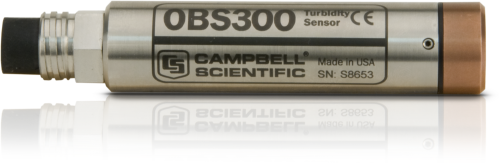This product is not available for new orders. We recommend ordering: ClariVUE10.

| Services Available | |
|---|---|
| Repair | Yes |
| Free Support | Yes |
Überblick
Der OBS300 ist ein versenkbarere Trübungssensor mit nach unten weisender Optik. Er verwendet die OBS® um suspendierten Festkörper und Trübung in z.B. Flüssen und Strömen zu messen. Er wird zur Bestimmung der Wasserqualität, zur Erforschung des Sedimenttransports oder zur Überwachung von Ausbaggerungen eingesetzt.
Der OBS300 wird direkt mit einem Campbell Scientific Datenlogger verbunden und berechnet dann die Trübung.
Lesen Sie mehrFunktionen und Vorteile
- Downward-facing optics avoid obstructions around the sides of the probe
- Measures suspended solids and turbidity for up to 4000 NTUs
- Provides a compact, low-power probe that is field proven
- Stainless-steel body allows use down to 500 m in fresh water
- Compatible with most Campbell Scientific data loggers
- Titanium body allows use down to 1500 m in fresh or salt water
- Accurate and rugged
- Fitted with MCBH-5-FS, wet-pluggable connector—multiple mating cable length options available
- Offers an optional five-point sedimentation calibration for better measurements (see Ordering Info on the web page)
Bilder




Technische Beschreibung
The OBS300 uses its downward-facing optics to emit a near-infrared light into the water. It then measures the light that bounces back from the water’s suspended particles.
If an obstruction is in the emitted light’s range, the light will scatter back and the turbidity reading will be too high. This probe's downward-facing optics avoid obstructions around the sides of the probe. The OBS-3+ is available for locations that have obstructions above and below the probe. (OBS® is a registered trademark of Campbell Scientific.)
Kompatibel mit
Please note: The following shows notable compatibility information. It is not a comprehensive list of all compatible products.
Spezifikationen
| Range |
|
| Maximum Submersion Depth |
|
| Maximum Concentration Range |
|
| Concentration Accuracy |
|
| Operating Temperature Range | 0° to 40°C |
| Drift over Time | < 2% per year |
| Maximum Data Rate | 10 Hz |
| Minimum Warm-up Time | 2 s |
| Infrared Wavelength | 850 nm ±5 nm |
| Daylight Rejection | -28 dB (re: 48 mW/cm-2) |
| Optical Power | 2000 µW |
| Turbidity Accuracy | 2% of reading or 0.5 NTU (whichever is larger) |
| Housing Material | 316 stainless steel or titanium |
| Connector | MCBH-5-FS, wet-pluggable |
| Diameter | 2.5 cm (0.98 in.) |
| Height | 13.1 cm (5.15 in.) |
| Weight | 181.4 g (0.4 lb) |
-2.5 Output Option |
|
| Output Voltage | 0 to 2.5 V (over selected NTU range) |
| Supply Voltage | 5 to 15 Vdc |
| Current Drain | 15 mA |
-5 Output Option |
|
| Output Voltage | 0 to 5 V (over selected NTU range) |
| Supply Voltage | 5 to 15 Vdc |
| Current Drain | 15 mA |
-20 Output Option |
|
| Output Voltage | 4 to 20 mA (over selected NTU range) |
| Supply Voltage | 9 to 15 Vdc |
| Current Drain | 45 mA |
Dokumente
Broschüren Produkte
Technische Artikel
- OBS and Turbidity Sensors Basics (2Q-P)
- OBS: Effects of Light Absorption and Scattering in Water Samples on Measurements
- OBS Sensors: Light Sources and Photodetectors
- OBS: Effects of Suspended Solids Concentration (SSC)
- OBS Measurements: Effects of Sediment Size
- OBS Measurements: Effects of Sediment Color
- OBS Measurements: Effects of Water Color
- OBS: Effects of Bubbles
- OBS Sensor: Effects of Fouling on the Lens
- OBS Sensors: Sediment Calibration
- OBS Sensors: Turbidity Calibration
- OBS: Comparison of Suspended Solids Concentration (SSC) and Turbidity
FAQs für
Number of FAQs related to OBS300: 16
Alle anzeigenWenige anzeigen
-
Typically, users use a clamp (a hose clamp, for example) to fasten the sensor to a permanent structure in the water so that the optics are orientated toward the open water.
-
The OBS-3+ or OBS300 provides two separate outputs to match the two turbidity ranges selected at the time of purchase. Use the curve that matches the turbidity range likely to be experienced during monitoring. Program the datalogger to record and store data from each output, or choose which output to use automatically depending on the turbidity.
-
Yes. The OBS300 is not harmed by being dry. The optics, however, need to be cleaned of any dust or contamination before the measurements are resumed.
-
Sensors are calibrated at the factory for measurements up to 4,000 NTUs, if requested at the time of order. Sensor ranges cannot be adjusted outside the factory.
-
The beam divergence angle of the sensor is 42°. (Within this 42° cone, 95% of the beam power is contained.)
-
The accuracy is 0.5 NTU or 2% of reading.
-
Campbell Scientific does not offer a display that can be attached directly to the sensor; however, the datalogger used to capture and record the data may have a display.
-
Possibly. Remember that the accuracy of the sensor is 0.5 NTU. If the drinking water standard is near 1, this sensor may not be a good match.
-
This has not been tested; however, it is likely that, as the sensor moves through the water, disturbances or bubbles are created that could distort the turbidity measurements.
-
No. A datalogger is necessary.
Anwendungsbeispiele
High-grade coal has been mined on the West Coast of New Zealand since the 1870s.......lesen Sie mehr
